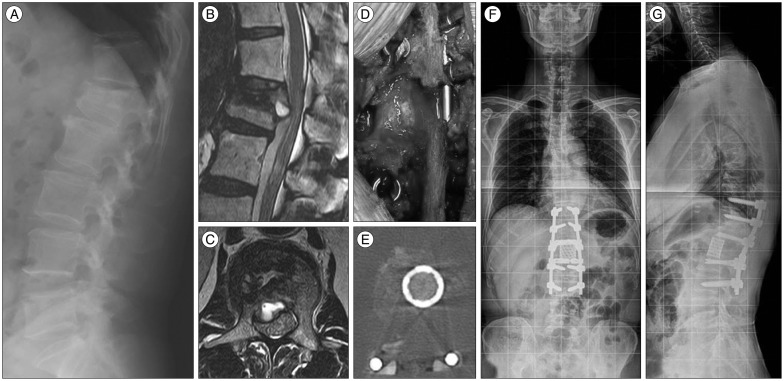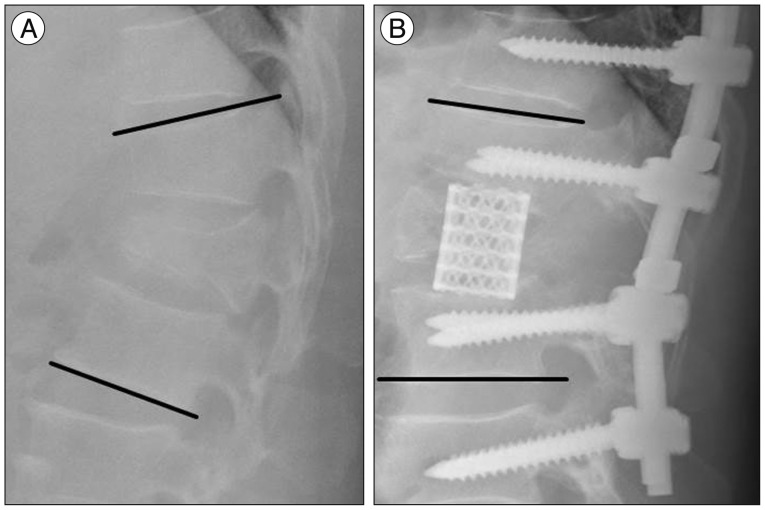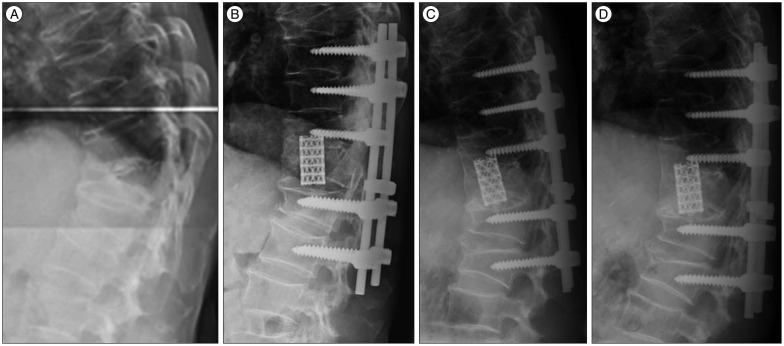J Korean Neurosurg Soc.
2016 Mar;59(2):122-128. 10.3340/jkns.2016.59.2.122.
Single-Stage Posterior Subtotal Corpectomy and Circumferential Reconstruction for the Treatment of Unstable Thoracolumbar Burst Fractures
- Affiliations
-
- 1Department of Neurosurgery, Spine Center, Kyung Hee University Hospital at Gangdong, Seoul, Korea.
- 2Department of Orthopedic Surgery, Spine Center, Kyung Hee University Hospital at Gangdong, Seoul, Korea.
- 3Department of Orthopedic Surgery, Chunchon Sacred Heart Hospital, Hallym University College of Medicine, Chuncheon, Korea. seoem@hallym.or.kr
- KMID: 2192041
- DOI: http://doi.org/10.3340/jkns.2016.59.2.122
Abstract
OBJECTIVE
To illustrate the technique of single-stage posterior subtotal corpectomy and circumferential reconstruction for the treatment of unstable thoracolumbar burst fractures and to evaluate the radiographical and clinical outcomes of patients treated using this technique.
METHODS
16 consecutive patients with unstable thoracolumbar burst fractures were treated with single-stage posterior subtotal corpectomy and circumferential reconstruction. The mean patient age was 54.8 years. The mean follower up period was 25 months. Five patients suffered from T12 fractures, 10 from L1, 1 from L2. The segmental kyphosis, neurologic status, visual analogue scale for back pain was evaluated before surgery and at follow up.
RESULTS
The segmental kyphotic angle improved from 18.5 degrees before surgery to -9.2 degrees at the last follow up. The mean correction angle was 28.9 degrees. The mean surgical time was 255 minutes, and a mean intraoperative blood loss was 1073 mL. Intraoperative complications included two dural tears, and a superficial wound infection. There were no other severe complications. The mean visual analog scale of back pain decreased from a mean value of 6.6 to 2 at the last follow up.
CONCLUSION
The single-stage posterior subtotal corpectomy and circumferential reconstruction achieved satisfactory kyphosis correction with direct visualization of the circumferentially decompressed spinal cord, as well as good fusion with less blood loss and complications. It is a safe and reliable surgical treatment option for unstable thoracolumbar burst fractures.
MeSH Terms
Figure
Reference
-
1. Acosta FL Jr, Aryan HE, Taylor WR, Ames CP. Kyphoplasty-augmented short-segment pedicle screw fixation of traumatic lumbar burst fractures : initial clinical experience and literature review. Neurosurg Focus. 2005; 18:e9. PMID: 15771399.2. Aebi M, Etter C, Kehl T, Thalgott J. Stabilization of the lower thoracic and lumbar spine with the internal spinal skeletal fixation system. Indications, techniques, and first results of treatment. Spine (Phila Pa 1976). 1987; 12:544–551. PMID: 3660081.
Article3. Akbarnia BA, Crandall DG, Burkus K, Matthews T. Use of long rods and a short arthrodesis for burst fractures of the thoracolumbar spine. A long-term follow-up study. J Bone Joint Surg Am. 1994; 76:1629–1635. PMID: 7962022.
Article4. Alanay A, Acaroglu E, Yazici M, Oznur A, Surat A. Short-segment pedicle instrumentation of thoracolumbar burst fractures : does transpedicular intracorporeal grafting prevent early failure. Spine (Phila Pa 1976). 2001; 26:213–217. PMID: 11154543.5. Altay M, Ozkurt B, Aktekin CN, Ozturk AM, Dogan O, Tabak AY. Treatment of unstable thoracolumbar junction burst fractures with short- or long-segment posterior fixation in magerl type a fractures. Eur Spine J. 2007; 16:1145–1155. PMID: 17252216.
Article6. Alvine GF, Swain JM, Asher MA, Burton DC. Treatment of thoracolumbar burst fractures with variable screw placement or Isola instrumentation and arthrodesis : case series and literature review. J Spinal Disord Tech. 2004; 17:251–264. PMID: 15280752.
Article7. Andress HJ, Braun H, Helmberger T, Schürmann M, Hertlein H, Hartl WH. Long-term results after posterior fixation of thoraco-lumbar burst fractures. Injury. 2002; 33:357–365. PMID: 12091034.
Article8. Ayberk G, Ozveren MF, Altundal N, Tosun H, Seckin Z, Kilicarslan K, et al. Three column stabilization through posterior approach alone : transpedicular placement of distractable cage with transpedicular screw fixation. Neurol Med Chir (Tokyo). 2008; 48:8–14. discussion 14PMID: 18219186.
Article9. Baker JK, Reardon PR, Reardon MJ, Heggeness MH. Vascular injury in anterior lumbar surgery. Spine (Phila Pa 1976). 1993; 18:2227–2230. PMID: 8278837.
Article10. Briem D, Lehmann W, Ruecker AH, Windolf J, Rueger JM, Linhart W. Factors influencing the quality of life after burst fractures of the thoracolumbar transition. Arch Orthop Trauma Surg. 2004; 124:461–468. PMID: 15243758.
Article11. Chang KW. A reduction-fixation system for unstable thoracolumbar burst fractures. Spine (Phila Pa 1976). 1992; 17:879–886. PMID: 1523490.
Article12. Chen HH, Wang WK, Li KC, Chen TH. Biomechanical effects of the body augmenter for reconstruction of the vertebral body. Spine (Phila Pa 1976). 2004; 29:E382–E387. PMID: 15371717.
Article13. Choi HJ, Kim HS, Nam KH, Cho WH, Choi BK, Han IH. Applicability of thoracolumbar injury classification and severity score to criteria of Korean health insurance review and assessment service in treatment decision of thoracolumbar injury. J Korean Neurosurg Soc. 2015; 57:174–177. PMID: 25810856.
Article14. Defino HL, Rodriguez-Fuentes AE. Treatment of fractures of the thoracolumbar spine by combined anteroposterior fixation using the Harms method. Eur Spine J. 1998; 7:187–194. PMID: 9684950.
Article15. Denis F. The three column spine and its significance in the classification of acute thoracolumbar spinal injuries. Spine (Phila Pa 1976). 1983; 8:817–831. PMID: 6670016.
Article16. Esses SI, Botsford DJ, Kostuik JP. Evaluation of surgical treatment for burst fractures. Spine (Phila Pa 1976). 1990; 15:667–673. PMID: 2218713.
Article17. Gurwitz GS, Dawson JM, McNamara MJ, Federspiel CF, Spengler DM. Biomechanical analysis of three surgical approaches for lumbar burst fractures using short-segment instrumentation. Spine (Phila Pa 1976). 1993; 18:977–982. PMID: 8367785.
Article18. Haiyun Y, Rui G, Shucai D, Zhanhua J, Xiaolin Z, Xin L, et al. Three-column reconstruction through single posterior approach for the treatment of unstable thoracolumbar fracture. Spine (Phila Pa 1976). 2010; 35:E295–E302. PMID: 20395775.
Article19. Hitchon PW, Torner J, Eichholz KM, Beeler SN. Comparison of anterolateral and posterior approaches in the management of thoracolumbar burst fractures. J Neurosurg Spine. 2006; 5:117–125. PMID: 16925077.
Article20. Jacobs RR, Casey MP. Surgical management of thoracolumbar spinal injuries. General principles and controversial considerations. Clin Orthop Relat Res. 1984; (189):22–35. PMID: 6383678.
Article21. Kaneda K, Taneichi H, Abumi K, Hashimoto T, Satoh S, Fujiya M. Anterior decompression and stabilization with the Kaneda device for thoracolumbar burst fractures associated with neurological deficits. J Bone Joint Surg Am. 1997; 79:69–83. PMID: 9010188.
Article22. Kawahara N, Tomita K, Kobayashi T, Abdel-Wanis ME, Murakami H, Akamaru T. Influence of acute shortening on the spinal cord : an experimental study. Spine (Phila Pa 1976). 2005; 30:613–620. PMID: 15770174.23. Kaya RA, Aydin Y. Modified transpedicular approach for the surgical treatment of severe thoracolumbar or lumbar burst fractures. Spine J. 2004; 4:208–217. PMID: 15016400.
Article24. Knop C, Fabian HF, Bastian L, Blauth M. Late results of thoracolumbar fractures after posterior instrumentation and transpedicular bone grafting. Spine (Phila Pa 1976). 2001; 26:88–99. PMID: 11148651.
Article25. Lee GJ, Lee JK, Hur H, Jang JW, Kim TS, Kim SH. Comparison of clinical and radiologic results between expandable cages and titanium mesh cages for thoracolumbar burst fracture. J Korean Neurosurg Soc. 2014; 55:142–147. PMID: 24851149.
Article26. Li KC, Hsieh CH, Lee CY, Chen TH. Transpedicle body augmenter : a further step in treating burst fractures. Clin Orthop Relat Res. 2005; (436):119–125. PMID: 15995429.27. McCormack T, Karaikovic E, Gaines RW. The load sharing classification of spine fractures. Spine (Phila Pa 1976). 1994; 19:1741–1744. PMID: 7973969.
Article28. Oskouian RJ Jr, Johnson JP. Vascular complications in anterior thoracolumbar spinal reconstruction. J Neurosurg. 2002; 96(1 Suppl):1–5. PMID: 11795693.
Article29. Park WM, Park YS, Kim K, Kim YH. Biomechanical comparison of instrumentation techniques in treatment of thoracolumbar burst fractures : a finite element analysis. J Orthop Sci. 2009; 14:443–449. PMID: 19662480.
Article30. Parker JW, Lane JR, Karaikovic EE, Gaines RW. Successful short-segment instrumentation and fusion for thoracolumbar spine fractures : a consecutive 41/2-year series. Spine (Phila Pa 1976). 2000; 25:1157–1170. PMID: 10788862.
Article31. Pflugmacher R, Schleicher P, Schaefer J, Scholz M, Ludwig K, Khodadadyan-Klostermann C, et al. Biomechanical comparison of expandable cages for vertebral body replacement in the thoracolumbar spine. Spine (Phila Pa 1976). 2004; 29:1413–1419. PMID: 15223931.
Article32. Sasani M, Ozer AF. Single-stage posterior corpectomy and expandable cage placement for treatment of thoracic or lumbar burst fractures. Spine (Phila Pa 1976). 2009; 34:E33–E40. PMID: 19127146.
Article33. Sasso RC, Best NM, Reilly TM, McGuire RA Jr. Anterior-only stabilization of three-column thoracolumbar injuries. J Spinal Disord Tech. 2005; 18(Suppl):S7–S14. PMID: 15699808.
Article34. Sciubba DM, Gallia GL, McGirt MJ, Woodworth GF, Garonzik IM, Witham T, et al. Thoracic kyphotic deformity reduction with a distractible titanium cage via an entirely posterior approach. Neurosurgery. 2007; 60(4 Suppl 2):223–230. discussion 230-231PMID: 17415157.
Article35. Shang J, Ling XD, Liu YC, Liu W, Xiao XG, Yuan SH. Biomechanical effects of pedicle screw adjustments on the thoracolumbar burst fractures. Chin Med J (Engl). 2013; 126:300–305. PMID: 23324281.36. Tezeren G, Kuru I. Posterior fixation of thoracolumbar burst fracture : short-segment pedicle fixation versus long-segment instrumentation. J Spinal Disord Tech. 2005; 18:485–488. PMID: 16306834.37. Tomita K, Kawahara N, Murakami H, Demura S. Total en bloc spondylectomy for spinal tumors : improvement of the technique and its associated basic background. J Orthop Sci. 2006; 11:3–12. PMID: 16437342.
Article38. Vaccaro AR, Zeiller SC, Hulbert RJ, Anderson PA, Harris M, Hedlund R, et al. The thoracolumbar injury severity score : a proposed treatment algorithm. J Spinal Disord Tech. 2005; 18:209–215. PMID: 15905761.39. Verlaan JJ, Diekerhof CH, Buskens E, van der Tweel I, Verbout AJ, Dhert WJ, et al. Surgical treatment of traumatic fractures of the thoracic and lumbar spine : a systematic review of the literature on techniques, complications, and outcome. Spine (Phila Pa 1976). 2004; 29:803–814. PMID: 15087804.
Article40. Westfall SH, Akbarnia BA, Merenda JT, Naunheim KS, Connors RH, Kaminski DL, et al. Exposure of the anterior spine. Technique, complications, and results in 85 patients. Am J Surg. 1987; 154:700–704. PMID: 3425822.41. Wood KB, Bohn D, Mehbod A. Anterior versus posterior treatment of stable thoracolumbar burst fractures without neurologic deficit : a prospective, randomized study. J Spinal Disord Tech. 2005; 18(Suppl):S15–S23. PMID: 15699801.
- Full Text Links
- Actions
-
Cited
- CITED
-
- Close
- Share
- Similar articles
-
- One Stage Decompression and Circumferential Stabilization by Posterior Approach in the Unstable Burst Fracture of Thoracolumbar and Lumbar Spine
- Anterior Fixation with Kaneda Device for Unstable Fractures of the Thoracolumbar Spine
- Treatment of Unstable Fracture of the Thoracolumbar Spine Using Kaneda Instrumentation
- Are “Unstable” Burst Fractures Really Unstable?
- MRI Findings of Posterior Ligament Complex Injury in Thorcolumbar Bursting Fractures




